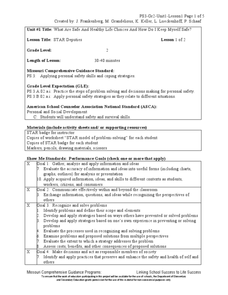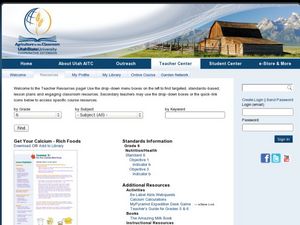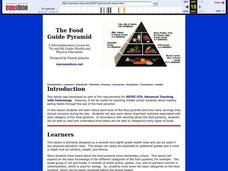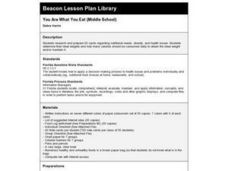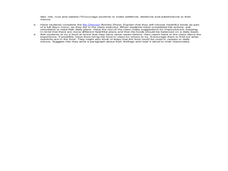Curated OER
Making Healthy Food and Activity Choices: Putting the Pyramid Together
Students work with the Food Guide Pyramid. In this Food Guide Pyramid instructional activity, students draw a large rendering of the food pyramid on a piece of butcher paper. They cut out pictures of foods and place them on the food...
Curated OER
Do I Need Insurance?
Explore the different types, costs, and coverage of insurance. High schoolers compare their family's health care to their income, compare the cost of health insurance to their expected future income, and make a choice about what type of...
Curated OER
STAR Deputies
Second graders engage in a lesson plan that is about the sharing of following rules to follow the law. They concentrate on the making of safe choices. Students use the examples to have class discussion. They also role play scenarios of...
Food Project
Trace The French Fry
How does locally grown produce sold at a farmer's market compare to a more complex industrial system in the way they each affect the environment, people, and the economy? Pupils explore the different types of food systems and how they...
Curated OER
My Favorite Breakfast Foods
First graders consider the importance eating breakfast. In this breakfast foods lesson plan, 1st graders plan meals, examine a variety of breakfast options, and discuss the food groups. Students taste a variety of foods. Extension...
Curated OER
ADULT ESOL LESSON PLAN--Level 5--Consumer Education
Students focus on identifying the differences between automobile, property, and health insurances. They also review the different cost for each and view a variety of brochures. In addition, they chart their findings to visualize all...
ProCon
Obamacare
Former President Barack Obama reformed the United States' health care system with Obamacare, but is the new legislation good for America? Scholars read a historical timeline about the passage of health care reform laws and compare United...
Curated OER
Get Your Calcium - Rich Foods
Fifth graders explore personal health by identifying positive food choices. In this calcium sources lesson plan, 5th graders discuss the common ways a human can receive calcium such as consuming dairy products. Students view a virtual...
Curated OER
The Secreat to Good Health: Eating Right and Exercise
Students create a seven-day record of all the foods they consume. They analyze what type of food was the most frequent in everyone's diet. They look up each food and record its daily recommended amount.
Baylor College
Serving Sizes
Are serving sizes for different foods always appropriate for what you need? For this hands-on activity, learners work in groups to estimate what one serving size of various foods are, and then evaluate their hypotheses by measuring real...
Curated OER
The Food Guide Pyramid
Students examine each level of the food pyramid and how many servings they should consume during the day. They study the important nutrients associated with each category of the food pyramid.
Curated OER
Food Labels in the Classroom
Students read all information given on packaging; write down complete ingredients and grams of protein, carbohydrates and fat per serving. They compare the information with current health references and write a business letter to a food...
Curated OER
Nutrition and the Media: Cereal Box Consumerism
How many treats do you buy each week? Learners investigate diets and how the media tricks consumers into purchasing unhealthy snacks. They will investigate the designs and logos affiliated with cereal boxes and identify specific phrases...
Texas Heart Institute
Nutrition: How Do I Choose the Right Foods?
Young learners discuss how to practice healthy eating habits and the body's need for energy through discussion and exploration of the MyPlate system.
ProCon
Drinking Age
Eighteen is the age of adulthood in the United States, but 21 is the legal drinking age. Pupils use the provided website to determine whether the age to legally purchase and consume alcohol should be lowered. They weigh the pros and...
Curated OER
Credit - Good? Bad?
Students examine credit cards. They explore the detrimental effects that result from debt and poor credit. Students analyze interest rates, minimum balances, and consumer debt. Students survey the benefits of credit cards.
Curated OER
The Hope to Cope: Coping Skills
Explore how to weigh the value of positive and negative coping skills in life situations with middle schoolers. They will be able to recognize the coping skills that they have used that been negative ways of coping with stress and look...
Curated OER
Trash...it really piles up!
Students investigate a contemporary "midden" by analyzing trash collected from various sources and determining life-style choices people make. They see that reducing the amount of waste we generate is helpful to the the environment.
Curated OER
A Teeth Changing Experience
Students research human health by reading an educational story in class. In this oral health lesson, students identify the importance of brushing their teeth and consuming calcium. Students read the book A Teeth Changing Experience and...
Curated OER
You Are What You Eat (Middle School)
Third graders determine what their ideal weights should be and how many calories should be consumed daily to obtain the ideal weight and/or maintain it. They research and prepare 20 cards regarding nutritional needs, obesity, and health...
Curated OER
Nutrition
Students create a video incorporating clay animation and skits. Using their video creation, students explain and explore the five basic food groups, nutrition news, nutrients, benefits and food examples. They maintain a food journal,...
Curated OER
How Do Foods Help Our Bodies
Students investigate the specific elements found in food that keep us healthy. In this healthy eating lesson, students identify proteins, carbohydrates, minerals, and vitamins as part of a healthy diet when consumed in moderation....
Curated OER
Caffeine and Nicotine
High schoolers research the effects of caffeine and nicotine online.
Curated OER
Information, Please
Young scholars view the video "Healthcare Crisis: Who's at Risk?" After researching various healthcare plans, students present their findings to the class.




